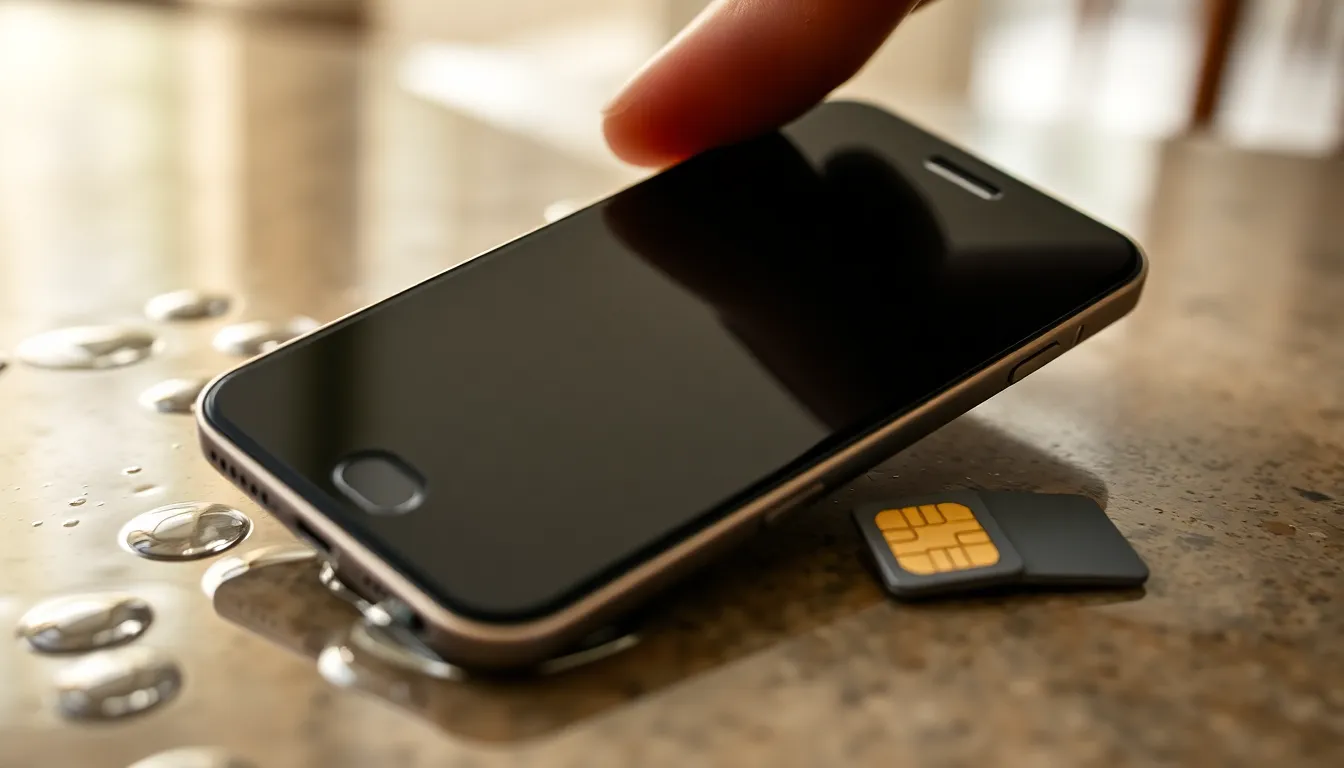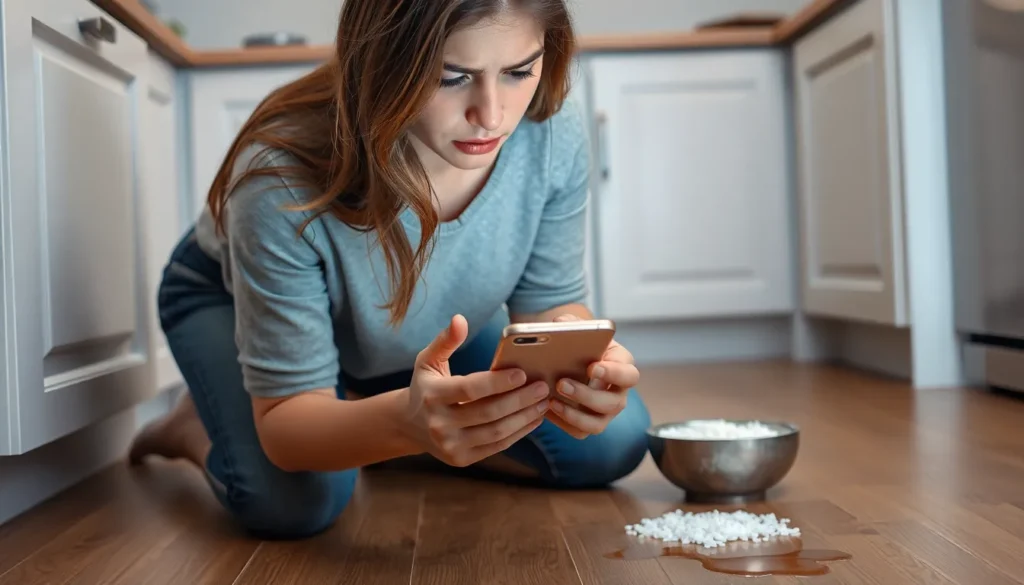Table of Contents
TogglePicture this: you’re enjoying a refreshing drink when, oops, your iPhone takes a dive into the depths of your beverage. Panic sets in as you envision your beloved device gasping for air. Water damage can feel like a tech death sentence, but don’t lose hope just yet!
Understanding Water Damage in iPhones
Water damage poses a significant threat to iPhones, often leading to irreversible harm. Awareness of the causes and signs can aid in mitigation efforts.
Common Causes of Water Damage
Accidental spills frequently lead to water damage in iPhones. Submersion incidents also occur during activities like swimming or showering. Rain exposure without proper protection contributes to moisture ingress. Furthermore, liquid exposure from sweat while exercising can compromise device integrity. Users must recognize these common scenarios to better safeguard their devices.
Signs of Water Damage
Physical indicators of water damage often include malfunctioning screens or unresponsive buttons. Distorted images or unusual colors appearing on the display signal potential issues. Users may notice unexpected battery drain and erratic device behavior. Additionally, condensation forming inside the camera lens denotes moisture intrusion. Recognizing these signs early improves chances of recovery.
Immediate Steps to Take After Water Exposure

Taking quick action minimizes damage to the iPhone. Immediate steps can significantly enhance recovery chances.
Powering Off the Device
Powering off the iPhone prevents electrical shorts. Start by holding the power button until the slider appears. Next, slide to power off. If the phone doesn’t respond, continue holding the power button along with the volume down button until it shuts down. Ensuring the device is off as soon as possible can protect critical components from further damage.
Removing Accessories and SIM Card
Removing accessories and the SIM card is essential for drying the device. Start by detaching the case and any connected gadgets, such as chargers or headphones. After that, eject the SIM card using a SIM tool or paperclip. Keeping the device free from accessories promotes better airflow and aids in the drying process, maximizing the chances of a successful recovery.
DIY Methods to Remove Water Damage
Individuals can attempt several DIY methods to remove water damage from an iPhone. Quick action enhances the chance of recovery.
Using Rice and Other Absorbents
Using rice as an absorbent can effectively draw moisture from the device. Users should fully immerse the iPhone in a bowl of uncooked rice for at least 24 to 48 hours. Other absorbents like instant oats or dry couscous also work well. Ensuring the device is sealed in a container with these materials maximizes absorption efficiency. It’s essential to avoid powering on the phone during this process.
Utilizing Silica Gel Packets
Silica gel packets provide another efficient method for moisture removal. Many people find these packets in shoeboxes or with new products. Users can place their iPhone in a container filled with silica gel packets for around 24 to 48 hours. The silica gel’s moisture-absorbing properties are effective at protecting the device. It’s recommended to keep the iPhone turned off to prevent further damage during this time.
Heating Techniques
Employing gentle heating can assist in removing moisture from an iPhone. A warm, dry environment encourages evaporation. Users can place the device in front of a fan or in a well-ventilated area. Avoid using direct heat sources like hairdryers, as excessive heat can damage components. Maintaining a moderate temperature ensures safer drying without risking harm to the device.
Professional Repair Options
If DIY methods fail to restore an iPhone, professional repair options become essential. Skilled technicians can provide expert assessments and solutions.
When to Seek Professional Help
Determining when to consult a professional can significantly influence recovery success. If the device shows persistent problems like unresponsive buttons, constant overheating, or compression in the display, it’s time to seek help. Continuous issues indicate potential internal damage that needs specialized attention. Professionals use advanced tools and techniques to assess and repair water-damaged phones effectively.
Choosing the Right Repair Service
Choosing a reputable repair service is crucial for successful recovery. Look for technicians certified by Apple or those who have experience with iPhone repairs. Checking online reviews or seeking recommendations from friends helps ensure trustworthiness. Some repair services offer warranties on their work, providing additional peace of mind. Ensure the service provides a clear estimate before proceeding, as transparency builds trust in the repair process.
Preventing Future Water Damage
Preventing future water damage to an iPhone involves proactive measures and awareness. Users can take specific steps to safeguard their devices from moisture exposure.
Using Waterproof Cases
Choosing a waterproof case provides a solid defense against accidental spills and submersion. Cases like the Lifeproof FRĒ or OtterBox Defender offer reliable protection during outdoor activities or near water. These cases often come with ratings that ensure resistance to water penetration. Investing in a quality waterproof case not only protects the device but also prolongs its lifespan. Selecting a case tailored to specific needs ensures the best fit for various activities and environments.
Awareness of Environmental Risks
Understanding environmental risks plays a critical role in water damage prevention. Users need to identify common scenarios that can lead to water exposure. For instance, keeping iPhones away from wet surfaces during cooking protects against splashes. Users should also avoid carrying phones in damp environments, like locker rooms or beaches. Awareness of weather conditions matters too; heavy rains can quickly lead to water damage if precautions aren’t taken. Observing surroundings and avoiding risky situations helps keep devices safe and functioning.
Recovering an iPhone from water damage is possible with prompt action and the right techniques. By understanding the risks and recognizing the signs of water exposure users can take immediate steps to minimize damage. DIY methods like using rice or silica gel can be effective if done quickly.
If these methods don’t yield results seeking professional help is crucial. Technicians equipped with the right tools can assess and repair damage that’s beyond DIY fixes.
Preventing future incidents is equally important. Using waterproof cases and being mindful of surroundings can significantly reduce the risk of water exposure. With the right approach users can keep their iPhones safe and functional for years to come.




